Types of Texas Wasps (With Pictures) – Identification Guide
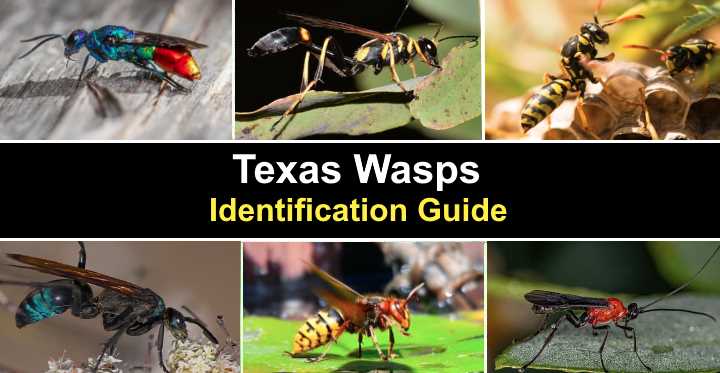
Texas is home to many types of wasps, ranging from the common yellowjacket to the red paper wasp and the cicada killer wasp. Many species of wasps in Texas play a vital role in the ecosystem. Beneficial wasps help pollinate flowers and also prey on harmful insects. However, many wasps have potentially dangerous stingers and can cause a nasty sting.
Identifying wasps in a Texas landscape is vital to protect yourself from a potential attack. Most wasps are solitary and are not aggressive. However, if they feel threatened, some species of wasps could become menacing and sting. Additionally, large hornets may send warning signals to other large wasps, and they could attack you.
This article is a guide to several species of wasps common in Texas. Descriptions and pictures of Texas wasps will help you identify them in the landscape.
How to Identify Wasps in Texas
Wasps in Texas can be identified by their colors, patterns, size, and flying habits. Wasps are also identified by the thin waist between the abdomen and thorax. Most common wasps are black and yellow, measuring less than 0.5” (13 mm) long. However, large hornets and cicada killers can measure over 1” (25 mm) long.
You can also identify wasps in Texas by their habitat. For example, some small red wasps build paper nests consisting of several tube-like structures. On the other hand, many species of solitary wasps burrow tunnels in the ground or wooden structures.
Texas Wasps vs. Bees
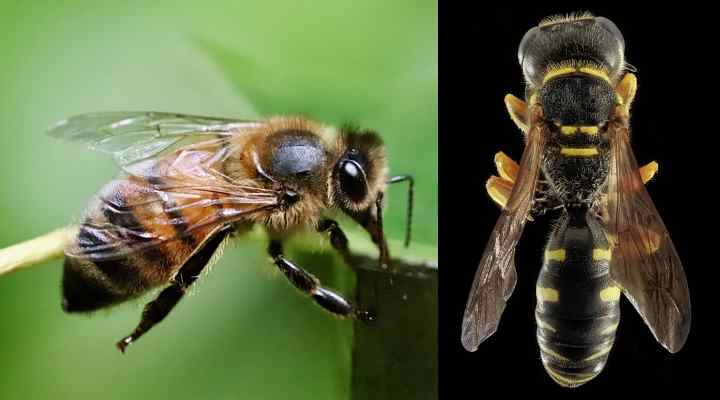
Close up pictures of a honey bee (left) and a wasp (right)
It can be challenging to tell wasps and bees apart. For example, some types of black and yellow wasps, like yellowjackets, and some paper wasps look like small honeybees. However, wasps tend to have smoother bodies and more vibrant coloration than bees. Additionally, most wasps have a recognizable thin waist, unlike bees which tend to be stockier.
Facts About Texas Wasps
Wasps are insects with wings that allow them to fly. Related to bees and ants, wasps belong to the insect order Hymenoptera. The smallest wasps in Texas are gall wasps, which are so tiny they are difficult to spot. The largest Texas wasps are cicada killers, measuring 0.6” to 2” (15 – 50 mm) long.
Despite having a reputation for being aggressive, most wasps rarely attack humans. And it’s typically only female wasps that sting. Therefore, although male wasps may fly menacingly and “get in your face,” they are completely harmless because they can’t sting humans.
Most wasps play a beneficial role in local ecosystems. Apart from being important pollinators, wasps act as pest controllers in Texas garden landscapes. For example, parasitic wasps can help control caterpillar populations because they feed on larvae.
Types of Texas Wasps (With Pictures)
Texas is home to many types of wasps, each with its own unique characteristics. Here are some of the most common types of wasps found in the Lone Star State.
Red Paper Wasps (Polistes carolina)
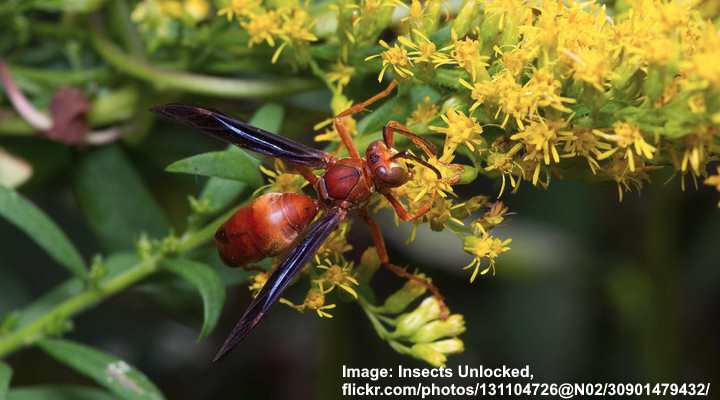
The large red paper wasp is common in Texas and can be identified by its reddish-brown body and black wings
One of the most common red wasps in Texas is the red paper wasp. This wasp species has reddish-brown coloring, long black wings, and a bulbous abdomen. Red paper wasps measure 1” to 1.26” (25 – 32 mm) long. The red wasps are common in the eastern United States from Texas to Florida.
Red paper wasps are social insects and construct papery nests. These structures look like an upside-down dome shape with honeycomb-like cells exposed at the base. The nests are commonly found in woodlands or on the undersides of roofs.
Texas wasp identification: Identifying features of the red paper wasp are its slender orange-brown or reddish-brown body and black wings.
Black and Yellow Paper Wasps
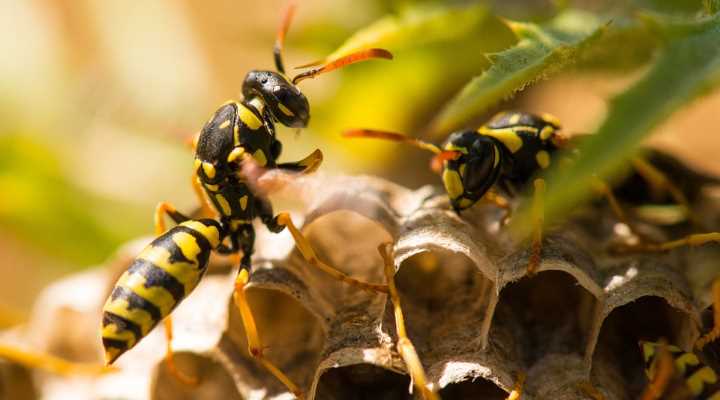
There are many species of paper wasps that vary in their appearance and coloring
Black and yellow paper wasps are easy to identify in Texas due to their vibrant yellow stripes on jet-black bodies. This species of paper wasp has orange to yellow legs, orange antennae, and brown wings. The wasps tend to be docile and only attack if the umbrella-like papery nest is threatened.
Black and yellow paper wasps measure around 1” (25 mm) long. Depending on the species, paper wasps in the tribe Polistini can be brown and black, brown with thin yellow stripes, or completely brown.
Texas wasp identification: Black and yellow paper wasps resemble yellowjackets and have black bodies with yellow markings.
Braconid Wasp (Atanycolus spp.)

The native Texas braconid wasp is a tiny red and black parasitoid wasp, with females having a long structure at the tail end to deposit eggs
The braconid wasp is native to Texas and is a small red wasp with black wings, a black head, and black antennae. This parasitoid wasp has an identifying feature of a long ovipositor—a needle-like tube females use to deposit eggs. The red wasps implant eggs inside insect larvae before consuming them alive after hatching.
Red and black braconid wasps measure 0.16” to 0.27” (4 – 7 mm) long. You can tell males apart from females because they lack the long tail-like structure used to deposit eggs.
Texas wasp identification: Red braconid wasps are identified by their tiny, slender brightly-colored red bodies with black wings, legs, and antennae.
Southern Yellowjacket (Vespula squamosa)

The black and yellow striped southern yellowjacket is a common wasp in Florida and Texas
The southern yellowjacket is one of the most common wasps in the southern states. This Texas wasp is identified by its alternating black and yellow bands on its abdomen. It also has two distinct vertical stripes just behind its head. The small, brightly colored wasps have lance-like stingers with small barbs and can sting repeatedly.
Southern yellowjackets measure 0.5” (13 mm) long. Other characteristic features include clear wings, yellow legs, and two black antennae. They are generally aggressive when provoked.
Texas wasp identification: Southern yellowjacket’s identifying features are its yellow band across its abdomen and distinctive yellow patterns on its thorax.
Eastern Yellowjacket (Vespula maculifrons)
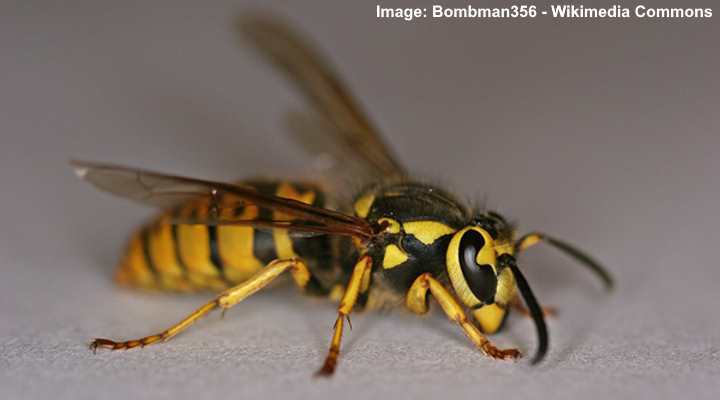
The black and yellow eastern yellowjacket is relatively small and lives in papery cone-like nests
The eastern yellowjacket is a common wasp species in Texas. The wasp is identified by black and yellow stripes on its abdomen. The stinging wasp lacks yellow stripes on its head and has a diamond-shaped marking on the thorax without vertical stripes like the southern yellowjacket.
The eastern yellowjacket has yellow legs and two stumpy black antennae. This black and yellow wasp measures 0.5” to 0.625” (13 – 16 mm) long.
Texas wasp identification: The eastern yellowjacket is identified by its curved body, black and yellow lines on its abdomen, and lack of distinctive patterns on its head.
Red and Black Mason Wasp (Pachodynerus erynnis)
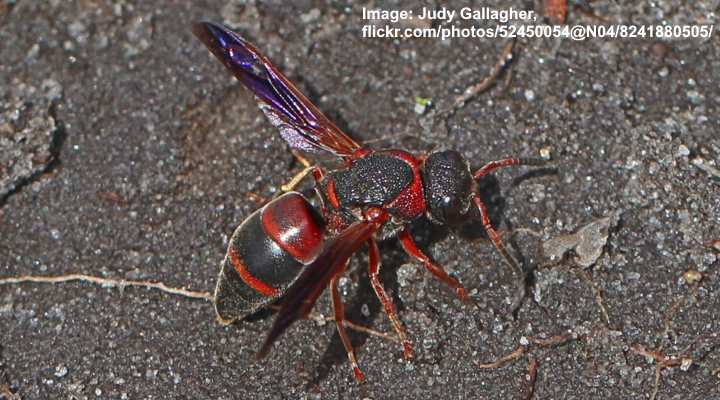
The small red and black mason wasp is common in Texas and southeastern US
The red and black mason wasp is found throughout Texas and nearby regions. The features of the wasp that help identify it are its rusty reddish-brown abdominal bands on a black body, red horseshoe shape on its thorax, and black head. Additionally, the male black and red Pachodynerus wasp has a conspicuous creamy-yellow marking on its face.
The red and black mason wasp is a predatory wasp measuring 0.28” to 0.55” (7 – 14 mm) long. It feeds on nectar and pollen and preys on the larvae of caterpillars, cutworms, and cabbage loopers.
Texas wasp identification: The red and black mason wasp is easy to recognize due to its distinctive dark red and black marks on its body, red wings, and orange-red legs.
Bald-Faced Hornet (Dolichovespula maculata)
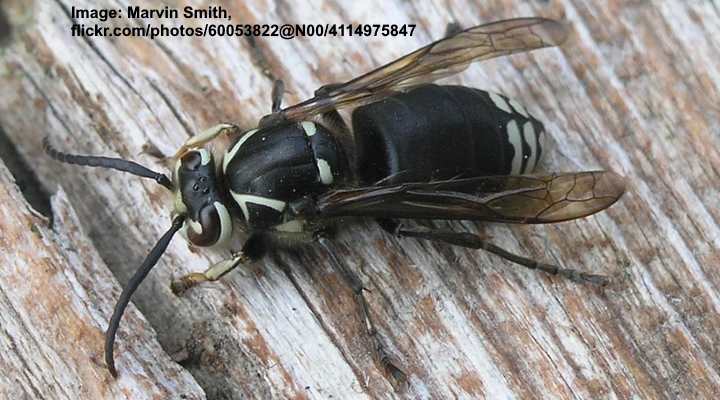
The bald-faced hornet is mostly black with several white markings on its body and can be found throughout Texas
The bald-faced hornet is a large black and white wasp commonly found throughout Texas. This aggressive wasp is characterized by its black-and-white striped pattern on the end of its abdomen. Additionally, it has a distinctive white patch on its triangular face, making it easily recognizable. The black wasp has whitish front legs and brown-black wings, and antennae.
The bald-faced hornet is a type of yellowjacket and will repeatedly sting to defend its dome-shaped papery nest. The white-striped black wasp measures 0.75” (19 mm) long. It tends to build nests in protected areas and can inflict a painful sting if you get too close to it.
Texas wasp identification: The bald-faced hornet has a black body with three white stripes at its tail end and a distinctive black T-shaped pattern on its white face.
European Hornet (Vespa crabro)

The large European hornet has black and red thorax and its abdomen is mainly black and yellow
The European hornet is the only true type of hornet found in the Lone Star State. This large wasp is identified by its black and red thorax, black and yellow striped abdomen, reddish-brown wings, and curled dark brown antennae. In addition, the European hornet has distinctive C-shaped eyes on its large head.
The European hornet measures 1” to 1.4” (25 – 35 mm) long. This large wasp species can be aggressive in defending its nest or around food sources. The hornets are active from early spring until late fall. It typically builds nests in dark, protected places like tree hollows or under eaves.
Texas wasp identification: The European hornet has an identifiable dark orange head, a dark brown thorax with orange markings, and a yellow abdomen with black or brown bands.
Eastern Cicada Killer Wasp (Sphecius speciosus)
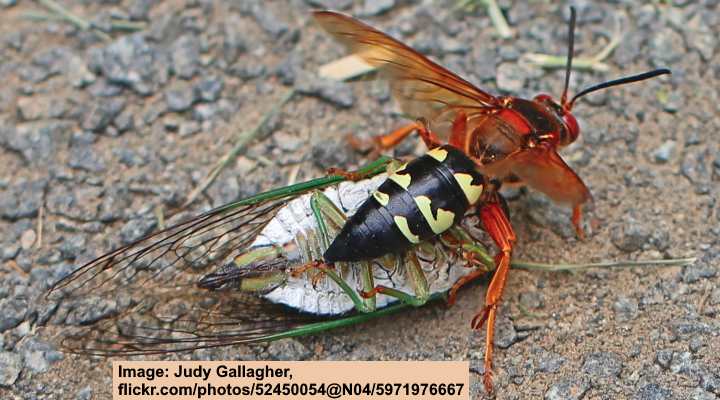
A picture of eastern cicada killer (Sphecius speciosus) with a cicada
The eastern cicada-killer wasp is a large wasp native to Texas. Measuring up to 2” (50 mm) long, it is also one of the largest wasps in the state. Identifying features of these “killer” wasps are their tear-shaped black abdomen with yellowish markings, orange-brown legs and wings, and a reddish head and thorax with black markings.
Despite their name, eastern cicada killer wasps are not aggressive to humans, and their stings are relatively harmless. However, the males have the habit of flying in rapid, jerking motions, which is easy to mistake for aggressiveness.
Texas wasp identification: The eastern cicada-killer wasp looks like a large yellowjacket or hornet with reddish legs and wings.
Mud Daubers (Apoidea)

The black-and-yellow mud dauber wasp (Sceliphron caementarium) can be identified by its very slim waist
Mud daubers are a group of flying insects common to most areas of Texas and other southern states. A common characteristic of all mud dauber wasps is their narrow, needle-like waist. Depending on the species, these slender wasps can be entirely black, black with yellow markings, or iridescent blue color.
Another characteristic of mud daubers is the distinctive tube-like nests they build from mud. Mud daubers range in size from 0.5” to 1” (13 – 25 m) long. In addition, mud daubers are typically harmless wasps.
Texas wasp identification: Mud daubers are easy to tell apart from other wasps due to their slender, stem-like waist.
Mexican Honey Wasp (Brachygastra mellifica)
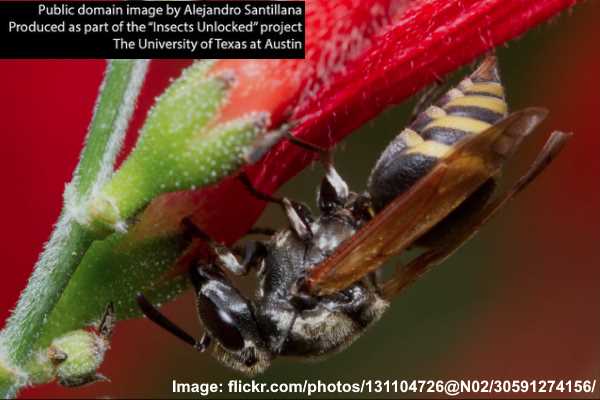
The Mexican honey wasp is commonly found in Texas and is mostly black with few yellow stripes at the rear end
The Mexican honey wasp is a species of yellow and black wasp native to the southern United States, especially Texas. This wasp has a black head, thorax, legs, and a tear-shaped black abdomen with several yellow bands around it. It’s a unique species because it’s one of the few honey-producing wasps in North America.
The Mexican honey wasp measures 0.27” to 0.35” (7 – 9 mm) long. It is common in the southernmost counties of Texas and Arizona.
Texas wasp identification: The Mexican honey wasp is a black flying insect with yellow bands across the tail part of its abdomen.
Great Golden Digger Wasp (Sphex ichneumoneus)
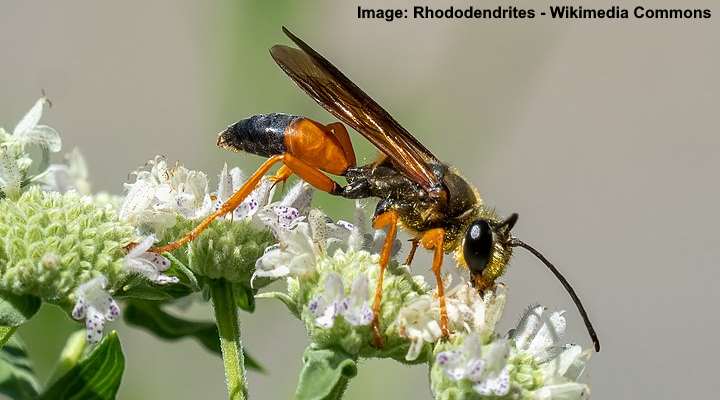
The large black and orange great golden digger wasp has big compound eyes with long antennae
The great golden digger wasp has a vivid black and orange body, sizable black oval eyes, slender curved black antennae, and three pairs of orange legs. Despite the threatening coloration of these wasps, they are relatively docile and leave humans alone. The black and orange wasps feed on nectar from colorful flowers.
Great golden digger wasps measure 0.6” to 0.9” (15 – 23 mm) long.
Texas wasp identification: The great golden digger wasp is easy to recognize due to its black and orange abdomen, orange legs, and large compound eyes.
Cuckoo Wasps (Chrysis spp.)
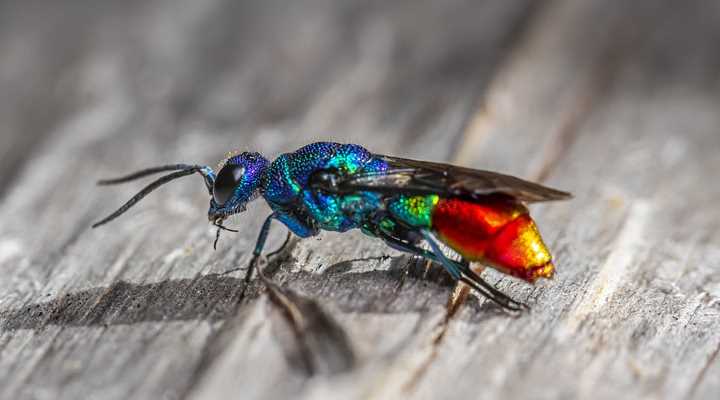
The cuckoo wasp is one of the smallest wasps in Texas and is easily identified by its iridescent body and red abdomen
The cuckoo wasp is one of the most unusual wasps you will find in Texas due to its distinctive color. The iridescent wasp has a metallic green head, thorax, and shimmering red abdomen. The rest of the wasp’s features—eyes, antennae, wings, and legs—are black.
Cuckoo wasps are extremely small wasps in Texas. They measure 0.19” to 0.31” (5 – 8 mm) long. However, despite their tiny size, they are easy to spot due to their iridescent colors.
Texas wasp identification: The cuckoo wasp has a distinctive metallic green, red, or gold body, making it easy to distinguish it from other small wasps.
Four-Toothed Mason Wasp (Monobia quadridens)
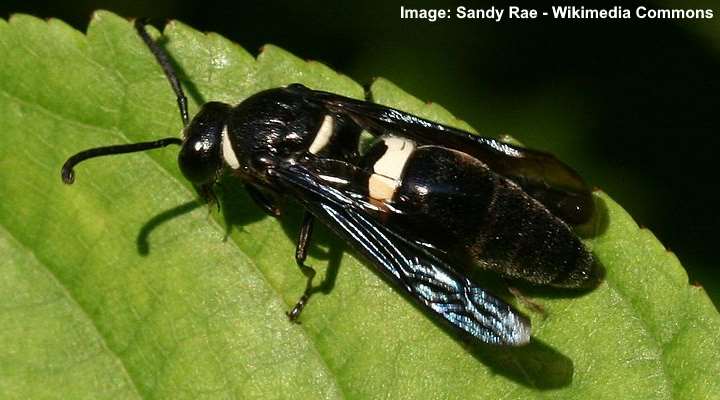
The black four-toothed mason wasp has creamy white band on the top abdomen
The four-toothed mason wasp is a striking flying insect due to its black appearance and brilliant white markings. Looking like a bald-faced hornet, the slender black wasp has a white band at the top of its abdomen and between its head and thorax. In addition, it has slender iridescent blue wings.
Like all mason wasps, the solitary four-toothed species builds its nests from mud—giving it the name potter wasp. The black wasps measure 0.59” to 0.82” (15 – 21 mm) long.
Texas wasp identification: The four-toothed mason wasp is easy to identify due to its jet-black, smooth body, with an ivory-white band below its thorax.
Great Black Wasp (Sphex pensylvanicus)
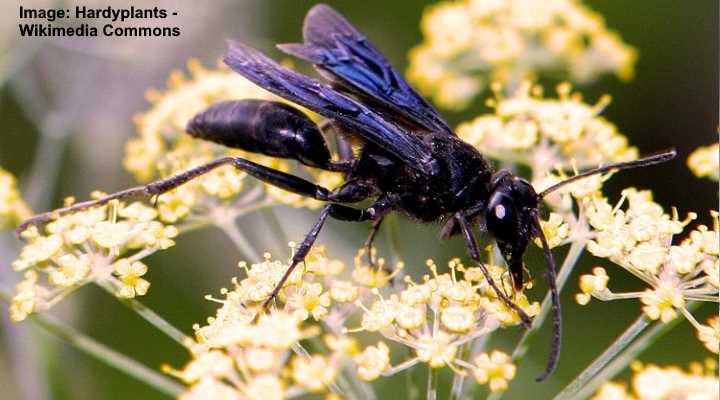
The great black wasp can be found in Texas gardens feeding on flower nectar
The great black wasp is a large wasp commonly found feeding on flower nectar in Texan gardens. Identifying features of the great black wasp are its steely-blue or black color, black wings, and thin waist between the thorax and abdomen. This type of black digger wasp constructs its nests in the ground.
The distinctive great black wasp males measure between 0.7” and 1.1” (19 – 28 mm) long, and the females are 1” to 1.3” (25 – 34 mm) long.
Texas wasp identification: The great black wasp is easy to identify due to its shimmering deep blue to black color.
Fraternal Potter Wasp (Eumenes fraternus)
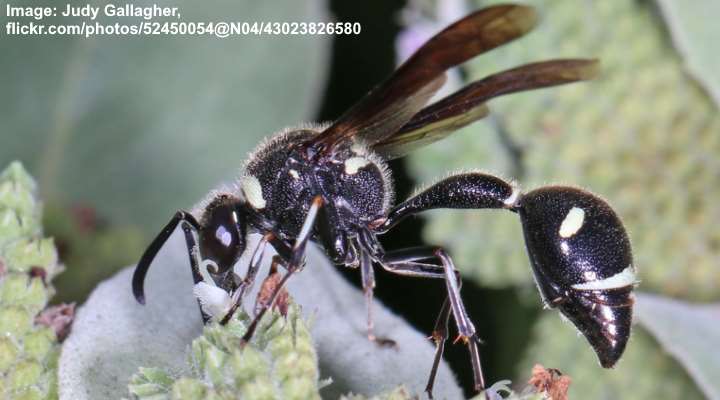
Fraternal potter wasps are common in Texas and are mainly black with a few creamy-white markings
The white-banded black potter wasp is an unusual-looking wasp common to the Lone Star State. The black wasp has a bulbous black abdomen and thorax joined by a slender waist. In addition, there is a single ivory-white stripe on each of its three body parts. The black and white wasp is active in Texas from April through November.
The black potter wasp measures 0.6” to 0.8” (15 – 20 mm) long. Like mud daubers, the white and black wasps create nests from mud.
Texas wasp identification: The potter wasp is easy to spot due to its shiny black, slender body with a whitish band across its abdomen and thorax and white markings on its head.
Tarantula Hawk Wasp (Pepsini)
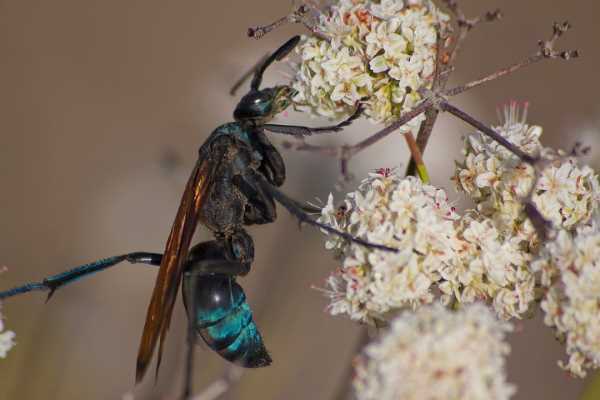
The huge tarantula hawk wasp is one of the largest in Texas and has a very painful sting
The tarantula hawk wasp is a brightly-colored, huge wasp with an iridescent bluish-black body and rust-colored wings. One of the unique features of this large black wasp is its painful sting. The female’s stinger can be 0.27” (7 mm) long, and it delivers one of the most powerful wasp stings in the world.
The large and powerful tarantula hawk wasp grows up to 2” (50 mm) long, making it one of the largest wasps in Texas. Depending on the species, the wasps could have metallic orange-tipped blue wings and reddish antennae.
Texas wasp identification: The identifying features of the tarantula hawk wasp are its large size, iridescent blue-black body, and reddish wings.
Related articles:
- Types of Wasps – Identification
- Brown Wasps – Identification Guide
- Black and Yellow Wasps – Identification
